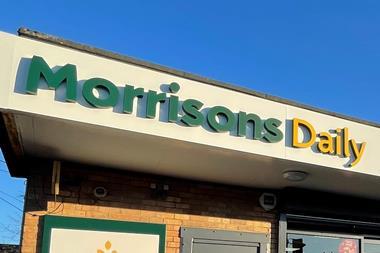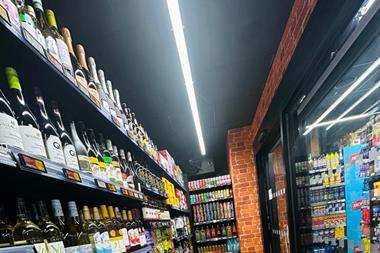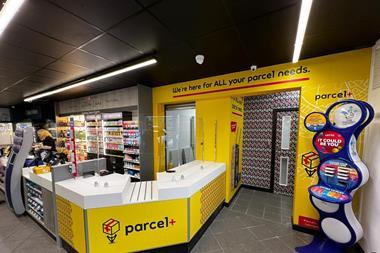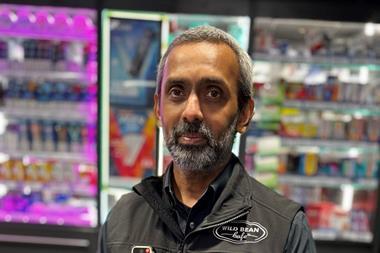
You might anticipate that expanding your business with another store will have its problems - building work snags, staffing and cash flow among them. But as retailers who have been through the process explain, one of the greatest trials can be keeping your previously rock-solid existing business strong as the pressures grow.
David Knight, owner of two Knight’s Budgens stores in West Sussex, was brutally honest about purchasing his second store when he spoke at the National Convenience Show (NCS) earlier this year. “I was very surprised at how challenging it was. I’m quite detailed, quite structured and I’d made lots of plans, and it really was a real eye-opener for us.”
Having a sound structure in place is crucial, agrees Londis brand director John Pattinson, who also spoke at the event. He told the audience: “When you’ve got your first store and you’re able to run it, see all four walls, touch everything and really understand it then that’s the time to think about what you do to expand, either inside the box, or outside into another store. It’s the stability and infrastructure making the store you’ve got successful that needs to be sound before you move on to the next one.”
David explained that this was the very reason he had bided his time. “We thought about store number two in the first year [of owning our first store] because we had quite a lot of success, but store number two didn’t come off for another three years. I think that had we made the jump that early it would have been a big challenge and a big disaster,” he conceded.
“We quickly realised that we needed to solidify our existing store first and make sure that it was profitable and that the processes and the systems were there and then we could actually seriously consider a second site.”
But despite holding off buying a second store for several years, David is the first to admit that things didn’t go to plan. “I was very arrogant when we went to the second store,” he said at NCS. “I naively expected to walk into the second store thinking that we would just replicate the success of the first. What actually happened was that I was spending 60 hours a week in the first store and suddenly I wasn’t because I needed to spend 60 hours a week in the second store. Things did slip.”
Despite having a full management team in both stores, things quickly began to unravel. “I had been at Hassocks so much that the team were reliant on me. They had been getting my time every day and suddenly they weren’t. Their ability to make decisions was reliant on me and so they stopped making decisions.
“We took a massive dip in morale, we lost some people. Comments like ‘you’re not interested in us’ were quite painful to hear, but we heard them a lot.”
David was forced to reassess his position within the company. “Now that I run two sites, we have 100 staff and a big turnover and I have to think differently about what my role is. My role is not as detailed as it was, but there’s a leadership piece that I missed out on with the first store,” he said. “They needed me to be their leader and once I’d understood my role, I can now look at a third store, a fourth store and a fifth store - which is our aspiration - in a different light to how I looked at store number two.”
Pattinson claims that neglecting your first store is an easy trap to fall into. “It’s about how you spread yourself as an individual,” he said. “When you go beyond two stores you have to think about the structure of the business carefully, because then your personal touch and support for the team becomes more diluted. That’s when you have to start to think about the structure around you as an individual that enables you to give the time to each of your individual businesses.”
Sat Deo, who owns three Costcutter stores in Yorkshire, has had to overcome this challenge in taking on his third store in Edlington. With capable managers in both his Wath and Maltby stores, he should have been in a good place. But the unfortunate departure of both store managers within six months of one another left him having to think fast to save his business.
“You have to start thinking of ways to make your life easier,” he asserts. “Staff training is the most important part of growing your business, so you don’t have to spend all your time in the store.”
Instead of employing new store managers, Sat opted to upskill his existing staff, empowering them to handle bigger tasks, while making considerable cost savings along the way. “I realised that if you train your staff enough, you don’t actually need a manager,” he explains.
He claims that his new approach has improved his business operations no end. “I’ve now trained several members of staff at each store to do ordering and cashing up, so that I wouldn’t have to be there as much.
“I still go to the store on a daily basis and do a store walk and spend one or two hours checking that everything has been ordered okay. It’s made me much more flexible. I can go to any store at any time and I’m not tied to anywhere. It also makes it less stressful if people go on holiday, because there is always someone who can manage the key roles.”
He points out that the decision to not take on store managers has also improved staff relations, as existing members of the team now feel more valued. “In the past, staff at my Wath store were constantly asking to learn how to do the ordering, but I didn’t really need them to because we had someone to manage that, but she left and I was thrown in at the deep end,” he says. “The staff like the responsibility and feel like they aren’t just a number.”
Raj Aggarwal was more than happy to leave staff to run his Spar Queens Drive store in Wigston, Leicestershire, when deciding to branch out. “Spar Queens Drive has been fine,” he says. “We’ve had the store since 1998 and it has just evolved with us.”
But that’s not to say that becoming a multi-site retailer has been in any way straightforward for Raj. The retailer had to close his Market Harborough store earlier this year, just eight months after opening (see box) and is now concentrating his efforts on Spar Hackenthorpe in Sheffield, which he purchased in November 2015.
“The challenge with multi-site retailing is that you think you can just multiply, but it’s not as easy as that,” says Raj.
Getting the new staff on board with his working methods has proved challenging. “Our Hackenthorpe store is great, but staff have been there a long time and they’re used to working a particular way, so I’ve had to spend a lot of time going through our ways of working - it’s a constant battle until you imbed it in them how you want the store run.”
He notes that if you are setting up a new build with a new workforce, then staff might be easier to mould. “If it’s a new site, staff can work how you want them to act straight away, but in our site the previous owner had been there for 26 years, so staff were set in their ways,” he says. “For example, the previous owner would never allow reps in and staff were told to send them away. We’ve asked staff to take down their numbers - we want to work with suppliers; they have a lot of knowledge.”
He also claims that his existing 26 years of running the Wigston store could only take him so far. “Each store is different - different demographic and different products sell well. There are a lot of ways of working template-wise that you can implement, but it all comes down to the area. For example, in one store you might sell loads of Mayfair cigarettes and in another it might be Lambert & Butler. You have to put your key learnings to use, but you also have to be willing to adapt.”
However, he is confident that the staff will take on board his initiatives over time. “We had to take all the existing staff under TUPE [Transfer of Undertakings (Protection of Employment) Regulations 2006] regulations, and we did, and I’m glad we did,” he states. “They’re hard workers.”
He spends five hours a day, three days a week at the store, but claims he has gone a week without seeing them, with them managing fine.
Trusting people to run your store is a key part of the process, Pattinson claimed in his CRA prsentation. “It comes back to delegation as a skill, an ability to be able to trust someone else to do something when you’re not there. You can’t be in three places ordering and three places taking a delivery and three places cashing up, whereas you used to be able to do that on one site.
“For me, it comes back to making sure that you trust the team you’ve got, that you set clear guidelines for them so that they can support you as much as you support them, and realising your own limitation.”
This was the conclusion that Richard Inglis drew when he decided to take on three stores. The owner of Parkview Retail in Southampton opened his third Co-operative Welcome store, Harbour Parade, in May 2015. “I don’t think people realise how hard it is to go from one to two stores and then two to three,” he says. “It became apparent I wouldn’t have enough time in the day to give the third store the same amount of time I was giving my other two stores.”
So he set about changing his management structure in order to adapt. “I promoted one of my store managers to operations manager. It meant an increase in staffing costs, but it was worth doing.”
Much of the preparation was about streamlining the business. “We had to look at a number of areas, including health and safety and risk assessments, making sure all the stores had the same staff noticeboards, the same IT set-ups, the same style of email,” he recalls.
He also introduced a workforce management system which meant that all members of staff could access different levels of information regarding staff rotas and pay.
In addition, he made the decision to move his business onto the cloud. “Before, I had one store with all of my information and so I’d get a phone call when I was in another store and I’d tell them that I’d have to go back to the office to check. Now I can tap into the system wherever I am.”
Richard claims that the business is in good shape now, but describes streamlining as a “a hell of a lot of work”.
David agrees that becoming a multi-site retailer can be hugely demanding. His advice to others looking to grow their business is to take the time to visualise an end goal. “The biggest thing to remember is to have a plan, understand what it is that you are trying to achieve, and make sure that the people you leave in the first store are competent and understand your vision. And don’t just focus on the second business; keep focusing on the first one.”
Taking decisions
Knowing when to let go

If taking on another store doesn’t go to plan, you need to know when to pull the plug to protect your remaining businesses. Raj Aggarwal made the difficult decision to close his Market Harborough store earlier this year.
Raj has been running his Queens Drive store in Wigston since 1998, but last year he decided to move from Londis to Spar. He then opened a state-of-the-art Spar store in a council building in Market Harborough in September, in addition to buying a third Spar in Hackenthorpe, Sheffield.
But even before the Market Harborough store had opened, Raj encountered major issues with Harborough council, from whom Raj was leasing the site. A dispute over rent led to the authority banning Raj from the building, changing the locks on the store, in addition to the adjacent café that Raj owned.
“The council took out a gagging order against me regarding internal politics,” he recalls. “As a council, you’d think they’d help a small business, but they decimated it.”
The store eventually opened in September 2015, but was struggling to attract the footfall required to make ends meet, largely thanks to poor visibility. “The council wouldn’t allow exterior signage because it’s a listed building - it was awful,” he says. “I’d walk in and realise that even I couldn’t tell the store was in the building - and it was my store! The council never helped, they added to the burden.”
As time went on, Raj was hopeful that he could turn things around, but it wasn’t to be. “I was losing nearly £4,000 a week at Market Harborough. We couldn’t sustain it any longer,” he says.
Eight months down the line and £100,000 down, Raj was forced to close the store.
“I can’t explain how heart-breaking it was to be 30 years in retail and to have to close your flagship store,” he admits. “I tried everything, but there was a lack of support from a number of areas.”
Learning from past mistakes

Richard Inglis (above) owns three stores in Southampton under the Welcome Co-op franchise, but when he took on the third store in Harbour Parade, he was determined to avoid previous pitfalls.
About eight years ago, Richard and his Dad, who has since retired, took on three stores under the Spar brand, and quickly got behind on their accounts.
“That sort of thing became a nightmare,” he says. “The management of the accounts was six or seven months behind. It’s great if you’re making money and don’t have to think about it, but if business takes a downturn, like ours did, then you don’t know why. That’s when you expose how frail you are.”
Richard ended up selling the underperforming store, going back to two outlets.
So with Harbour Parade, he was determined to get it right. He began by planning out a new way of working. “I decided to slow it down and really think about the process - how the rotas will work, having paperwork in a central place, file storage and so on.”
This involved considering how his own role within the business would change. “Now the company operations manager deals with the sales and staff and I deal with bill payments, taxes and invoices,” he says.
“We tried to simplify things as much as possible. We have filing cabinets at each store. Staff know where to put invoices and then I take them to put onto the cloud. We never miss a bill and every supplier is paid on time. I’m never more than two or three weeks behind with paperwork, even if I’ve been on holiday.”





















No comments yet